Today’s post was first sent out last Summer, which means most of you won’t have seen it. I am reposting it as part of a larger plan: as I was answering these questions, I realised I had a lot more to say and so I am slowly working my way through them and turning them into larger essays — this repost is an intro to those.
There is also a secret plan related to this post, but that is all I can tell you about it right now (look at me building up tension and trying to pique your curiosity…).
If you are one of the 50 people that read this post already back in June, my apologies — I will have something new for you next time. In the meantime, perhaps you will enjoy watching this video, where you can see the first decoration stages of my latest large vase to the sound of
’s mesmerising music:Uncut - Slip Decoration to the Sound of Explorations
This clip is not edited in any way - I only hit pause a few times to mix colours and a couple of times I got interrupted by the dog.
I also take this opportunity to remind you of the special offer I announced at the beginning of the month to celebrate Clay on my mind’s first anniversary: to send you for free — wherever you are in the world — a mug, espresso set or any piece or pieces up to a value of €30 when you take an annual subscription (value €28, or less than €2.50 per month).
Please know that your support means the world to me — whether or not you choose to upgrade your subscription plan. If however, you are able and willing, upgrade now! Then, head over to my Etsy shop and either hit reply if you are reading this in email, or send me a message over Chat if you are using the Substack app, and let me know your choice. I will be thrilled to see my pots find their way into the hands of people who really care.
~~ This offer is valid until the end of April ~~
In any case, if a paid membership is not something for you but you like what you see on my Etsy shop and would like to buy a unique pot handmade in my home studio — that’s also a great way to support my work (see link above 😉)!!
On to the post… Here it is, with some edits and some typos fixed…
~~
This week’s letter is a bit different than previous ones. I have noticed that I don’t “talk” as much about pottery and clay as I was planning to, or rather, as I expected to. That’s ok, I am still figuring things out. But this week I thought I would go a bit deeper into clay.
This is, however, a bit problematic, as the subject is vast and I really have no clue where to start. I already wrote about the time I met clay in an earlier post, which you can read here:
And so, what to talk about next?
In order to find out, I decided to ask myself a few questions and see which ones I really enjoy answering, which ones “spark joy” as Marie Kondo would say. In other words, which ones are worth keeping and digging a bit more into, and which ones I can give up on and live without. The former could then become subject of future posts whereas the latter could be forgotten (or filed under “what to write about when really desperate to come up with what to write about”).
The questions I decided to ask myself are questions I have seen asked of other potters in pottery publications I have read over the years. When I read them and the potter’s answers, I would always wonder what my own answers would be. If I’m completely honest, I sometimes play these “interviews” in my head. Amazingly, however, I never attempted to properly articulate my answers and much less write them down. Until now.
I have to say I am quite nervous about this. What if I can’t answer the questions? What if I have really nothing to say about any of the topics asked? What if my answers suck? It’s a good thing I know the questions in advance, but still…
OK, enough dillydallying, let’s get to it.
Q: Let’s start with an easy one… What inspires you?
A: Come on! That is a difficult one, that’s not easy at all... I am not sure I can pinpoint a source of inspiration, really. I love looking at nature: flowers, plants, trees. I try to understand the shapes, the forms, how they all come together. But I am not sure how that translates into inspiration. Someone has described my pottery as “nature inspired” but I am not sure that is accurate. Maybe it is… Lately, I am curious about landscapes, especially as seen from afar or from above. I also like looking at fabrics and old Japanese prints. How it all works to then become something I decorate my pots with, that I cannot explain. Ah! I do get inspiration from my previous work, weirdly enough. Sometimes I see a pot I made some years before and notice a detail I like and will think of a new way to use it, or of different ways to develop it.
Q: Do you make pots with specific foods in mind?
A: I don’t think so. There is a bread cloche I have been thinking about making but never really get to it. My rectangular trays are meant to be used for loaf-type cakes, but I don’t really emphasise that. I like to think that the person buying one of my pots will find the best way to use it that suits them.
Q: What is your favourite form to make?
A: I would have to say mugs and my rectangular trays. I really enjoy handbuilding mugs — it took me some time to figure out a shape and size that I liked and then how to make it so I am happy with it. For the longest time, my mugs were wonky-looking, never really round and rather clumsy. I think the ones I am making now are still clearly handbuilt but… well, I think they are beautiful, but I am biased, of course. Another thing I love about these mugs is the handle. I read somewhere that a pulled handle would look out of place on a handbuilt mug, and so for a long time I was making the handle separately and attaching it. It looked ok, but I was not 100% happy. Until I decided to ignore what I had read and tried making my mugs with pulled handles anyway. It takes a lot of practice to pull handles properly (I still get a lot of fails), but I immediately knew that was how I would make my handles from then on.1 I suppose there are no right or wrong handles and it really is a matter of personal choice, but for me a handle can make or break a pot (pun intended, usually the handle is the weakest point on a pot). Anyway, that was not the question, but I think I could write a whole essay on handles alone…
I also really enjoy making my rectangular trays because they are a very simple form; and because they are flat, the decoration possibilities are endless and much easier to execute than on a mug or a bowl (by the way, bowls are my least favourite form to make).
Q: Can you describe your making process or one of the methods you use?
A: Right now, I do more handbuilding and only occasionally will use the wheel. I don’t own a slab roller and I am not sure I ever will, as it is a costly piece of equipment which also takes up a lot of space. So, I roll small slabs by hand as I need them, usually only big enough to cut out a tray, or a mug and a plate, for example. For the trays, plates and small and medium bowls, I use bisque moulds I made myself; these are used to form the slabs and keep them in the desired shape until the clay is stiff enough to handle without deforming (this is called, in potter lingo, the leather-hard stage), at which point I can start decorating. The mugs and beakers are cut from cardboard templates then assembled, and the larger forms — vases and bowls — are made using a mix of slab and coils.
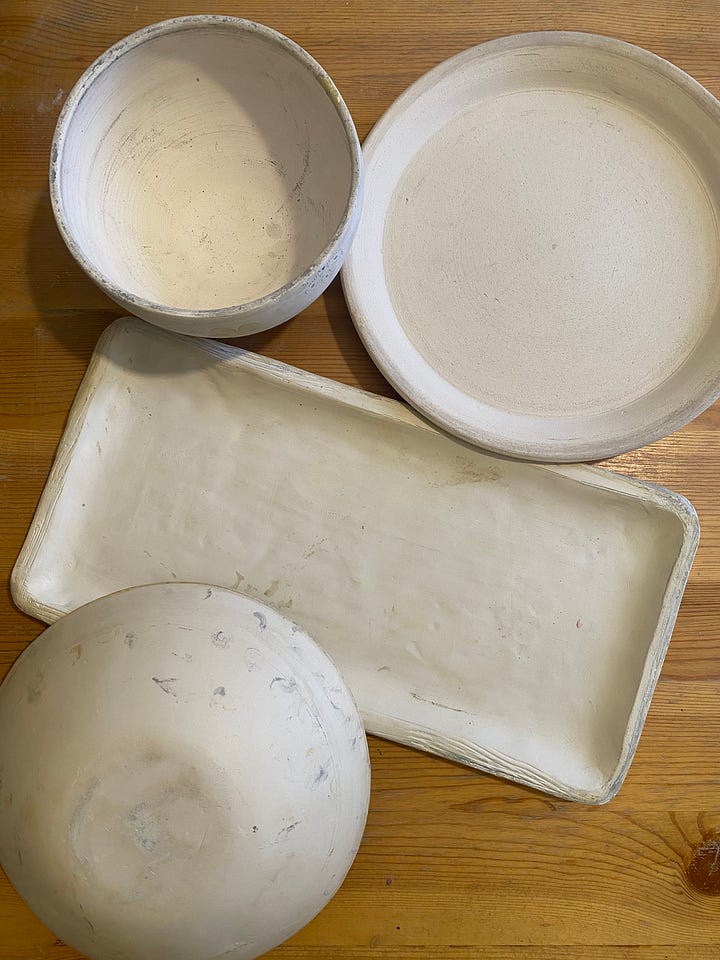
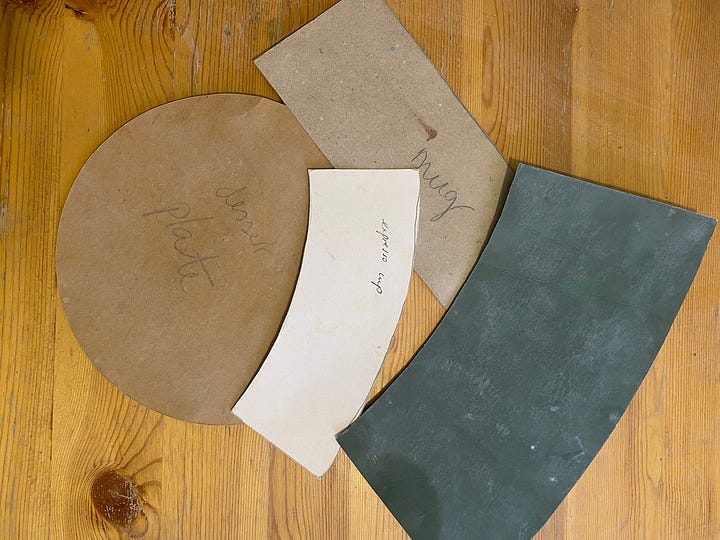
Q: Do you have any favourite tools?
A: Yes! I love my sgraffito tools. Actually, my most favourite tool broke recently and I have been trying to postpone replacing it by trying out other tools I already had and didn’t really use. It’s been interesting finding out the marks that these other tools make, but they are not the same. I will probably end up buying the old one again. I also love some brushes I have had for years now — unfortunately, I have forgotten where I bought them.
Q: Is there something in pottery you would like to try but aren’t able to at the moment?
A: Yes! I would like to try different types of firing methods. Once a year or so, I join a local group of ceramists to do raku, pit firing and saggar (links will take you to Wikipedia, but there are loads of other resources on these topics, if you are interested) — all different low fire techniques that can produce stunning results. I personally don’t like saggar, mostly because of all the waste it produces (although there are ways to do it without using foil, which seems to be the preferred method nowadays). But what I would love to try and am not able to at the moment is high firing techniques, such as soda and salt firing. These can produce amazingly atmospheric pots but require specialised kilns and, usually, a lot of firewood. Yes, when I grow up I want to build my own wood-fired kiln.
Q: Are there any aspects to pottery or being a potter that you are less happy about, that bother you or that you struggle with?
Yes. I struggle mostly with the fact that I am constantly adding to the already huge amount of objects in the world. Over the years, as I have become more aware of this fact, I try to fire only those pots I am really happy with. Of course, things can still happen in the glaze firing that I cannot control, but as much as I can, during those stages of making which I do have control over, if a pot doesn’t feel right it goes into the reclaiming bucket. And then, there’s also the other materials used, like oxides and pigments, and of course, all the minerals needed to make a glaze… Pottery is not an impact-less art, that’s for sure. There are ways of minimising this, but, well, it’s not easy. I have started to look for natural clays around me and use them in my pots. I have found one that fires light yellow or a straw-like colour, and ones that fire different shades of dark terracotta red. I process them and use them as slips, and it is an amazing feeling to do this. But of course, it’s still a far cry from harvesting enough clay to make the pots — that clay is still shipped in (usually from Germany and Czechia).
Well, that’s it. I rather enjoyed that, in the end. And now I know what I would like to write more about. Success!
Over to you: Are there any questions you would like to ask me? Maybe there’s a question above or a topic I touched on that you would like me to elaborate on?
Let me know in the comments (or hit reply if you are reading this in your email client), I would love to hear form you.
~~
I hope you enjoyed this self-interview as much as I enjoyed reflecting on these topics. Next time, I will expand on one of them as well as update you on what I’ve been up to in the studio. Until then, take care and thank you so much for reading!
xx Sara
You can find out more (a lot more!) about pulling handles in this YouTube video by Florian Gadsby — that’s how I learned to do it, by watching his videos on pulling and attaching handles.
If you would like to see my work
My Etsy store is a constant work in progress; I recently added a large sgraffito bowl and a small raku bowl to the listings. I am also on Instagram, though more and more I wish I weren’t.
And if you think your friends would also enjoy reading Clay on my mind, consider sharing it with them.

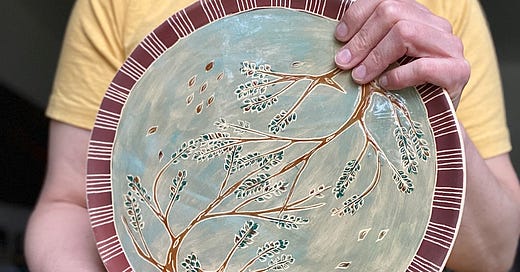




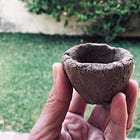
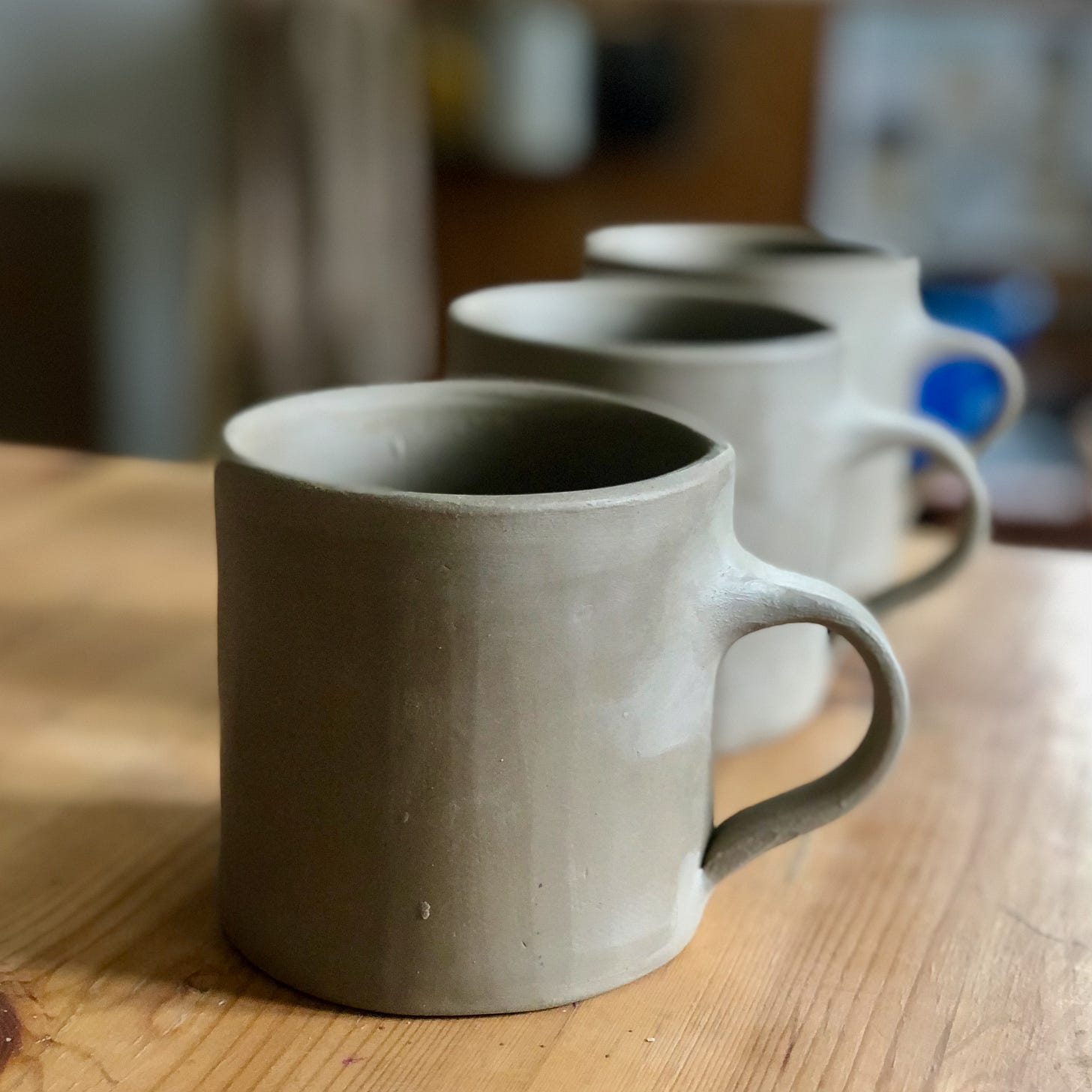
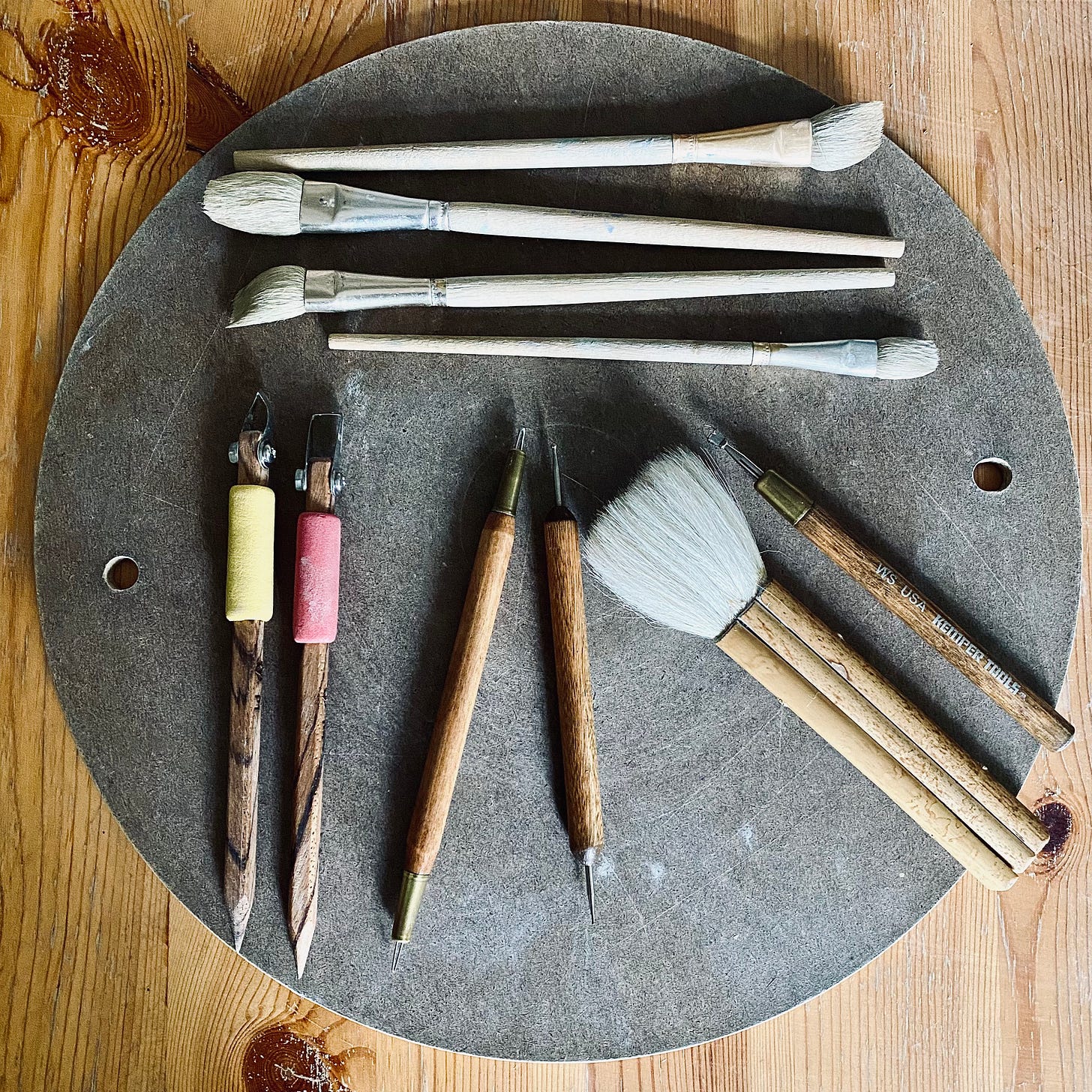
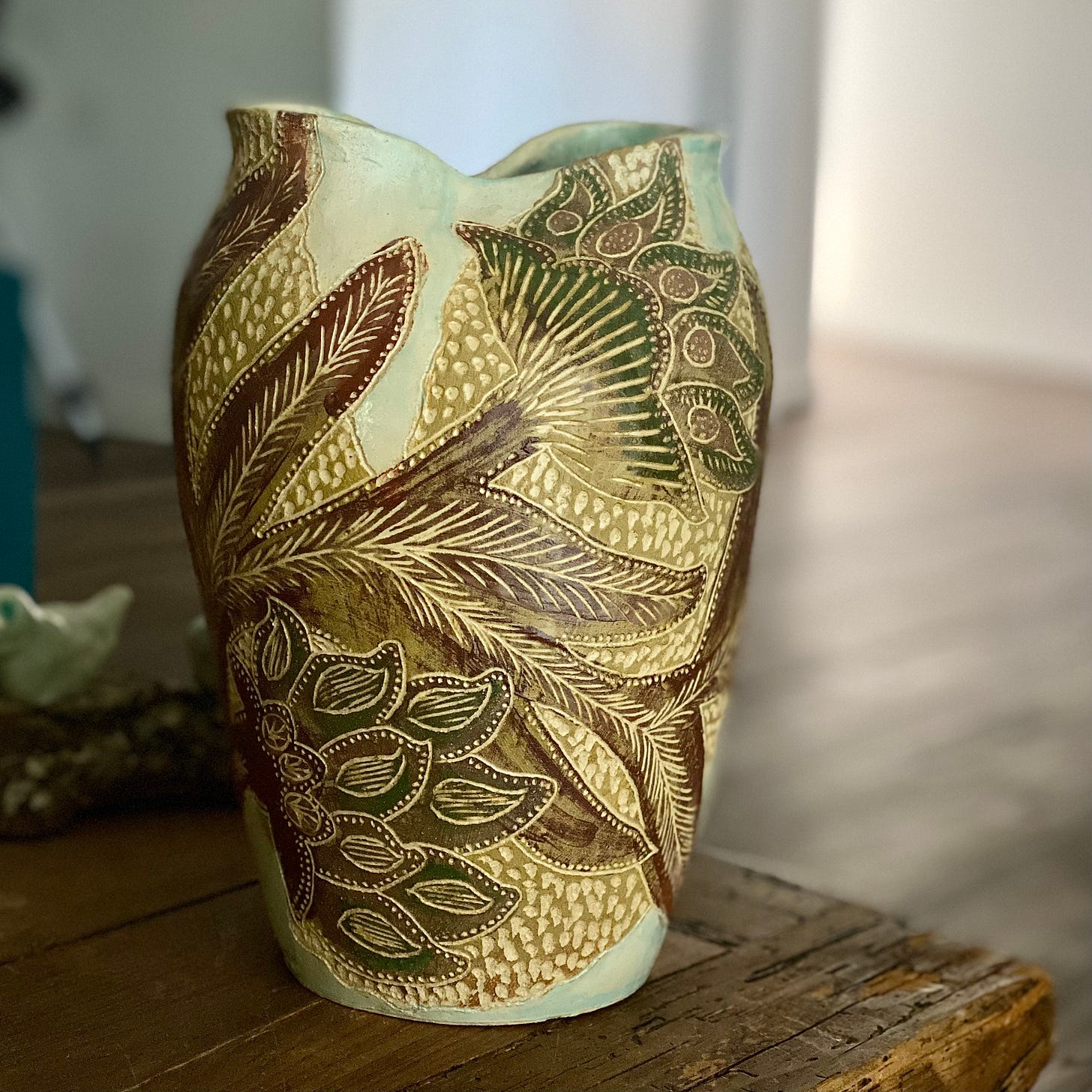
Gostei destas reflexões sobre a prática. De acordo com a minha experiência (não em cerâmica, como sabes), é assim que se progride.
Só mais duas observações: o vaso é LINDO!!!!; podes não gostar muito de fazer taças mas eu adoro as que tens feito.
Continua, minha querida!
thank you for sharing these insights into your process. And that gorgeous vase!